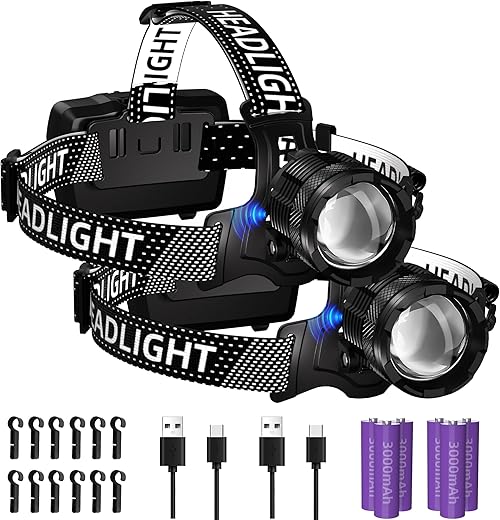







Understanding the Sudden Shortening of Headlamp Battery Life
In the world of outdoor adventures, having a reliable headlamp is essential. Whether you’re hiking under the stars, camping in the woods, or working on a home project, a headlamp provides hands-free illumination. However, many users have experienced the frustrating phenomenon of a sudden decrease in battery life. What causes this unexpected shift, and how can you mitigate it? Let’s dive into the intricacies of headlamp battery life and uncover the reasons behind its sudden shortening.
The Basics of Headlamp Batteries
Headlamps typically use various types of batteries—alkaline, lithium-ion, or rechargeable nickel-metal hydride (NiMH). Each of these has its own characteristics, advantages, and drawbacks. For instance, alkaline batteries tend to be less expensive but drain quickly under high usage, while lithium-ion batteries provide a longer lifespan and reusability but can be more costly upfront.
But here’s the kicker: the type of battery isn’t the only factor determining your headlamp’s longevity. Environmental conditions, usage habits, and even the headlamp’s design play significant roles in battery performance.
Factors Contributing to Battery Drain
When you notice your headlamp’s battery life plummeting, several culprits might be at play:
1. **Usage Patterns**
How often do you use your headlamp, and at what brightness settings? Most headlamps offer multiple brightness levels. Using the highest setting consistently can rapidly deplete the battery. Think of it as driving your car in high gear all the time—it’s going to consume more fuel, right?
2. **Temperature Extremes**
Just like you might feel sluggish in frigid temperatures, batteries also struggle in extreme cold. Cold weather can reduce the effectiveness of battery chemistry, leading to decreased performance. Conversely, excessive heat can cause batteries to degrade faster. It’s akin to storing a bottle of wine in a hot attic—over time, it spoils.
3. **Battery Age and Storage**
Batteries aren’t immortal. Over time, they naturally lose their capacity. If you’re using old batteries, that’s a likely reason for the sudden drop in performance. Additionally, how you store your batteries matters too. Leaving them in a headlamp for extended periods, especially in unfavorable conditions, can lead to a chemical reaction that diminishes their longevity.
4. **Quality of Batteries**
Not all batteries are created equal. Cheaper, off-brand batteries may save you bucks initially but often fail to perform under strenuous conditions. Investing in quality batteries can be likened to choosing a sturdy pair of hiking boots—they might cost more, but they’ll endure the journey better.
5. **Headlamp Design and Technology**
The design of your headlamp can also influence battery life. Features like LED technology, which is energy-efficient, can extend battery life compared to older incandescent bulbs. Additionally, some modern headlamps come with smart technology that adjusts brightness based on ambient light, optimizing power consumption.
Tips to Maximize Headlamp Battery Life
Now that we’ve identified the potential reasons for a decline in battery performance, let’s look at some strategies to prolong your headlamp’s battery life:
1. **Adjust Brightness Settings**
Use the lowest brightness setting necessary for your activity. Save the high beam for when you truly need it. This simple adjustment can significantly extend your battery life.
2. **Store Properly**
If you’re not using your headlamp for an extended period, remove the batteries. Store them in a cool, dry place to prevent damage. Think of it as tucking your winter coat away in a closet until the cold months return.
3. **Choose Quality Batteries**
Invest in reputable battery brands. While it might seem like a minor detail, quality batteries can make all the difference.
4. **Regular Maintenance**
Keep your headlamp clean and check for corrosion regularly. A clean connection between the battery and the headlamp ensures optimal performance.
Conclusion
Understanding the reasons behind a sudden drop in your headlamp’s battery life can empower you to take corrective actions. By being mindful of your usage habits, environmental conditions, and the batteries you choose, you can ensure that your headlamp remains a reliable companion on all your adventures. Remember, a little knowledge goes a long way in preserving your gear and enhancing your outdoor experiences.
FAQs
1. How can I tell if my headlamp battery is dying?
You may notice a dimming light or flickering when the battery is low. Additionally, if the headlamp takes longer to turn on or only works intermittently, it might be time to replace the battery.
2. Is it better to use rechargeable batteries in my headlamp?
Yes, rechargeable batteries are often more cost-effective and environmentally friendly in the long run. They can provide consistent power and reduce waste.
3. Can I use regular alkaline batteries in a rechargeable headlamp?
While it’s technically possible, it’s not recommended. Using non-rechargeable batteries in a rechargeable headlamp can lead to leakage and damage. Always check your headlamp’s specifications before mixing battery types.
